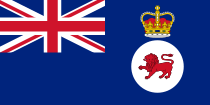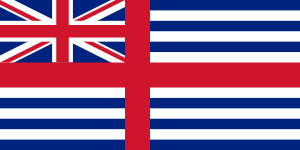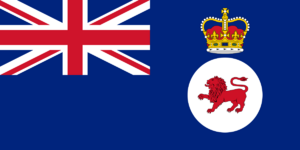Flag of Tasmania facts for kids
 |
|
| Use | Civil and state flag |
|---|---|
| Proportion | 1:2 |
| Adopted | 25 September 1876 |
| Design | State badge of a red lion passant on white disk, on a defaced British Blue Ensign |

Standard of the Governor of Tasmania
|
|
| Use | Other |
| Proportion | 1:2 |
| Adopted | February 1977 |
| Design | State badge of a red lion passant on white disk surmounted by St Edward's Crown, on a defaced British Blue Ensign |
The flag of Tasmania is the official flag for the Australian state of Tasmania. It was officially chosen on 25 September 1876. This happened after a special announcement by Tasmania's colonial Governor, Sir Frederick Weld. The news was shared in the Tasmanian Gazette on the same day.
Before 1856, when Tasmania gained the right to govern itself, people mostly used the Union flag and the British ensign. These were used for important state events. The current Tasmanian flag has a modified British Blue Ensign. This means it's a blue flag with the Union Flag in the top left corner. It also has Tasmania's special badge in the fly (the part of the flag that flies free).
The badge is a white circle with a red lion walking across it. No one knows exactly why the lion was chosen for the flag. However, many believe the red lion represents Great Britain. This flag has stayed almost the same since 1875. There was a small change to the lion's design when the government officially adopted the flag in 1975. But it had actually been made official by the colonial government way back in 1876.
Contents
History of the Tasmanian Flag
Tasmania became a British possession a long time ago. In 1856, it gained the power to govern itself. But it didn't get its own flag until Queen Victoria suggested it on 7 August 1869. She thought Tasmania and other Australian colonies should have a Union flag with their own special badge in the middle. Before an official flag was chosen, an unofficial merchant flag was sometimes used.
Tasmania's first local flag was adopted on 9 November 1875. This flag had a white cross on a blue background. The Union Flag was in the top left corner. In the fly (the outer part of the flag), there were five white stars forming the Southern Cross. Government ships were to use a British Blue Ensign with a white cross. Private ships were to use a British Red Ensign with a white cross. The Southern Cross stars were added above and below the horizontal arm of the cross.
However, these flags were quickly changed just two weeks later, on 23 November. Henry Herbert, 4th Earl of Carnarvon, who was in charge of the colonies in London, made it clear. He said that only one badge could be placed on the fly of the ensign. This was a rule from the British Admiralty, which managed naval affairs.
A year later, the Tasmanian government decided on a new badge. With the British Admiralty's approval, they chose a red lion on a white circle. The lion was first planned to be gold, but they went with the more traditional red.
Tasmanian government ships used a British Blue Ensign with this new badge. Private ships used a plain British Red Ensign. After Tasmania became a state on 1 January 1901, the Tasmanian Blue Ensign was not used as often. It was mostly kept for official events. Most ships then started flying the Australian Red Ensign.
On 3 December 1975, Governor Sir Stanley Burbury made a new announcement. This was supported by Premier Bill Neilson. It officially made the current flag the Tasmanian flag. Even though it was technically already 'official' since 1876. Since 1975, regular people can also use the flag, but it's not very common to see them do so.
Symbols on the Flag
The flag of Tasmania has two main symbols. These are the Union Flag (also called the Union Jack) and the State Badge of Tasmania.
The Union Flag is on many Australian flags, including the Flag of Australia. People in Australia often think it shows Australia's past as six British colonies. It also represents the ideas behind the Australian Federation. However, historically, its presence on the flag showed loyalty to the British Empire.
How the Flag is Made
Unlike Australia's national flag, the flag of Tasmania is not protected by special laws from the state or Commonwealth government. This means there are no official legal rules for how the flag must be made. However, people generally follow these traditional guidelines:
- The Union Jack should be in the top quarter closest to the flagpole.
- The rest of the flag, the fly, should be entirely blue. This matches the British Blue Ensign.
- The State Badge should be placed in the middle of the fly. It should be about one-third of the way up from the bottom of the flag.
Colours of the Flag
The exact colours for the flag are not set by law. But they use the same colour codes as the national flag. The Australian Government's Style Manual also provides specific colour codes for printing and showing the flag on screens.
| Scheme | Blue | Red | White |
|---|---|---|---|
| Pantone | 280 C | 185 C | Safe |
| RGB (Hex) |
0-0-139 (#00008B) |
255-0-0 (#FF0000) |
255-255-255 (#FFFFFF) |
| CMYK | 100%-80%-0%-0% | 0%-100%-100%-0% | 0%-0%-0%-0% |
Governor's Flag
The Governor of Tasmania is the Queen's representative in Tasmania. The Governor has an official flag for all formal events. This flag looks very much like the Tasmanian flag. The only difference is that it has a St. Edward's Crown above the badge. This crown shows the Governor's important role.
When the Governor is at Government House, this flag flies from the roof. It is also used as a flag on the Governor's car. The Governor of Tasmania's flag became official in February 1977. This was done through a law passed by the Parliament of Tasmania.
Images for kids
See also
 In Spanish: Bandera de Tasmania para niños
In Spanish: Bandera de Tasmania para niños





